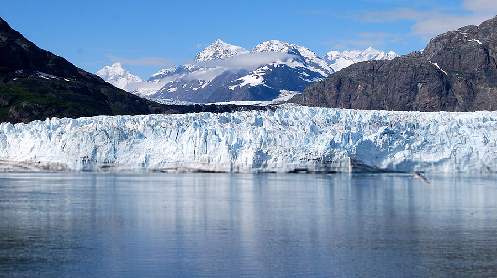Melting glaciers may be capable of shrinking much faster than scientists previously thought, according to a new study that adds to concerns about rapidly melting Antarctic ice, including the massive Thwaites Glacier, often called the “Doomsday Glacier” for its potential effect on sea-level rise.
The review, distributed in Nature, found that millennia prior, ice sheets in Europe withdrew by up to 2,000 feet every day — in excess of a quarter-mile — for brief periods. That is the quickest rate at any point recorded and far quicker than past examinations had proposed was conceivable.
The discoveries could give new knowledge into the destiny of the present ice sheets and may recommend that icy masses in advanced Greenland and Antarctica could soften surprisingly quick.
That incorporates a portion of the world’s greatest and most foreboding glacial masses, for example, Thwaites, which contains sufficient ice to raise worldwide ocean levels by two feet all alone.
Thwaites imparts a few qualities to the quickly withdrawing European icy masses of old. A few pieces of the ice sheet lay on top of smooth, level bedrock — the sort of geology that might assist with working with short eruptions of serious icy mass retreat, as indicated by the new stud.
“One of the primary zingers of our paper is that under a proper pace of liquefying, you would get especially various paces of retreat over various bed shapes,” said Christine Batchelor, an ice sheet master at the College of Newcastle in the Unified Realm and the new review’s lead creator.
The fast eruptions of icy mass retreat happened millennia prior, when the last ice age was attracting to a nearby and a large part of the Northern Half of the globe was canvassed in ice.
The review took a gander at the ocean bottom off the shore of Norway. Colossal chunks of ice rested there close to the furthest limit of the last ice age, around 15,000 to quite a while back. Today, the ice is gone — however indications remain, remembering edges for the rough sea floor that show where the ice moved and settled as the ice sheets dissolved and shrank.
By examining how much space between the edges, the researchers estimated how rapidly the ice dissolved and withdrew after some time.
They found that the spots with the quickest paces of retreat happened in the region with the flattest bedrock. It’s basic physical science, the scientists recommend. Ice is less thick than water — and in these level regions, with no slanting bedrock squeezing toward the lower part of the glacial mass, ice is particularly light. It almost drifts over the ground.
That probably made it simpler for the ice sheets to slip in reverse over the bedrock as they liquefied and disintegrated into the ocean.
The investigation likewise discovered that the quickest beats of retreat were fleeting, enduring only days or a couple of months all things considered. In any case, losing hundreds or thousands of feet of ice every day amounts to significant misfortunes — and significant commitments to worldwide ocean level ascent — much over brief periods.
The discoveries add another layer to’s how researchers might interpret the variables influencing icy mass retreat. As of recently, analysts have commonly expected that the most noteworthy paces of retreat happen in places with steep geography, where the bedrock slants inland away from the ocean, making it more straightforward for ice to slide in reverse as it liquefies.
The two hypotheses are presumably right, however in various ways, Batchelor said. Over significant stretches, inclining bedrock will in general work with higher paces of ice misfortune. Yet, over brief periods, level bedrock considers little beats of very quick retreat.
The two situations can cause enormous degrees of ice misfortune. Also, both develop more serious and more risky the quicker the ice is softening.
The new review takes note of that the Norwegian ice was possible encountering incredibly high liquefy rates during its explosions of fast retreat. Quicker softening assists the ice with separating from the bedrock, making it simpler for the ice sheet to disintegrate and withdraw.
The liquefy rates were possible higher than the dissolving saw all things considered glacial masses in present-day Antarctica. In any case, Batchelor said, even the ongoing melt rates in Antarctica joined with the flattest areas of bedrock “may as yet wind up with retreat rates on the request for many meters each day.”
That is the very thing caused them to notice places like Thwaites.
As of not long ago, Thwaites was withdrawing at a speed of around one kilometer every year. It’s as of now balanced out itself on top of an edge in the bedrock, and it’s hazy when it might start moving inland once more. In any case, when it does, the glacial mass is somewhere around four kilometers from an area with moderately smooth level bedrock — the sort of spot where beats of quick retreat could happen.
The researchers doesn’t know fast retreat will happen should the glacial mass hit that spot. Yet, it’s plausible, they say — one that might have been neglected before the new exploration was finished.
The new discoveries can assist researchers with refreshing PC models they use to foresee the eventual fate of the world’s ice sheets, Batchelor added. Further developed demonstrating can provide researchers with a superior thought of how the quick, brief beats of retreat might influence ice sheets all over the planet.
Researchers actually aren’t certain about “the more extensive impact of what occurs on the ice sheet after you’ve had one of these heartbeats,” Batchelor said. “We don’t know whether the ice balances out again after it’s accomplished a beat of fast retreat — or on the other hand in the event that that could get rolling a more extensive arrangement of ice dynamic reactions that could prompt further misfortunes.





